#this post was brought to you by the fact that i was extracting fonts from mkv files and went
Explore tagged Tumblr posts
Text
we really could've had it all once industry started to officially license and release anime and manga in the west. we could've made the sequel to .ass files, or made professional standard quality software to improve the editing experience for their frankly janky-ass markup and formatting. we could've had tools to make burning styled subs to videos easier, or better yet we could've made rendering and styling subtitles more of a thing in html/css/js for browsers to maintain the flexibility of softsubbing.
but mostly, i'm thinking abt how cool it would've been for the norm in overseas anime releases to have the licensing company commission graphic designers to make custom fonts to match the subtitle styles to the texts and vibes in the anime itself.
#this post was brought to you by the fact that i was extracting fonts from mkv files and went#'ah yes. ghandi sans. again.' bc that is like THE default subtitle font for anime these days lmao#and tbh i kind of get it it's a neat font well-made and it can be good to standardize these sorts of things#some part of me just wishes that different groups had their own signature default styles#like i just find that tiny bit of individuality charming#also i'm pretty sure some groups just attach a bunch of system fonts that they DON'T EVEN USE IN THEIR RELEASES to every file by default#and i'm just like. 'BUT WHY???????????' LIKE YOU'RE JUST BLOATING YOUR FILE SIZE AT THIS POINT...#花話
5 notes
·
View notes
Text
EXPERIMENTS & PROCESSES
Initially, I started experimenting with a range of processes to gauge a better understanding of the strengths and weaknesses of certain mediums in the context of my theme. This mostly involved experimenting with ink and its effect on different surfaces. I used cartridge paper, fabric, canvas board and wood; experimenting by dropping ink from different distances to see what effect it would make. On the wood and canvas board I found that the ink naturally spread out a lot and so decided to blend different colours together to form a murky effect. I also used sandpaper to distress and take away some of the ink; an act of creating trace and alluring to fragmented memory. To take this further, I spent time experimenting with a range of materials to see how I could create this effect in a more effective manner. I therefore tried layering glue on top of the dried ink and then sanding it as it began to dry so as to reveal certain parts of the original stained wood (see artwork labelled 1). I also tried creating a cracked paint effect by painting over the top of a glue layer (see work labelled 2) however this was not particularly successful; perhaps due to the type of paint I used being quite thin.
At this stage of making, I was very much gauging my understanding of conceptualising my subject matter, whilst trying to let loose enough to begin allowing my own emotions and experiences to drive the work. It was initially quite difficult to allow myself the freedom of doing this due to an overriding need to feel somewhat in control of my practice. However, I found that by allowing myself to explore one medium in a range of ways with no direct end result in mind, this helped me to feel more comfortable.

Mark making:
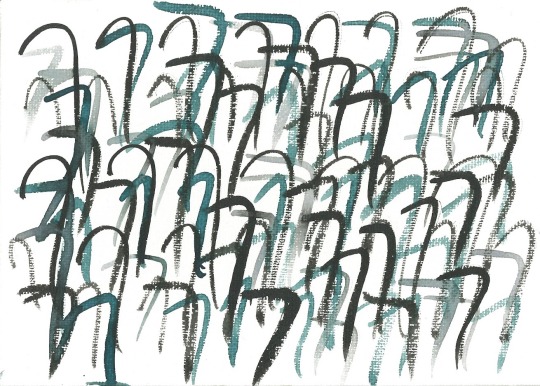
After this initially testing period, I began delving into the more personal aspect of the work. This involved mark making from extracts of photographs of the interior of the last house I lived in with my mum before she left (please see post dated 09/01/2020 for a detailed description of my process in this regard). This led me to start experimenting with making drawings of these marks through a range of mediums. I started off by creating little drawings referencing the marks and their meanings by the means of text (please see *drawn, stitched, ... in my sketchbook). However I found that the text wasn’t really necessary when used in conjunction with the marks due to their significance alone. I realised that I could my poetry to influence understanding in this respect.

During my group crit with Sarah, Carola, Emily and Ben it was mentioned that I should try engraving as a means of creating objects from the marks in their own right, almost as an ode and act of permitting permanence to the memories in question. I started thinking about the ways in which I could achieve this and considered a range of mediums. I thought about using plaster blocks/clay and engraving into those, as well as etching; however it felt as though my thought processes were much more drawn to the act of using drawing to achieve this notion. I therefore started experimenting with drawing on cartridge paper with a needle. I began by simply using the sewing machine normally but found that it gave me less control over the shapes I intended to make. I therefore started manually making the individual holes using the balance wheel. I found that this was much more effective as it allowed me to think carefully about making each hole in order to make the final mark. The act of turning the wheel just enough to pierce the paper and apply more or less pressure also made the act of making feel much more fragile; emulating the sensitive nature of what the marks represent.
The conceptual underpinning of this process is the fact that once the paper has been pierced, it cannot be undone. Unlike stitching onto fabric, it can be unpicked with little trace of the stitch remaining. However, the act of marking the paper with these marks in such a way emulates the permanence of the traces of time and place they represent.

With sewing machine pedal.

Manually adjusting balancing wheel on sewing machine.
Poetry:
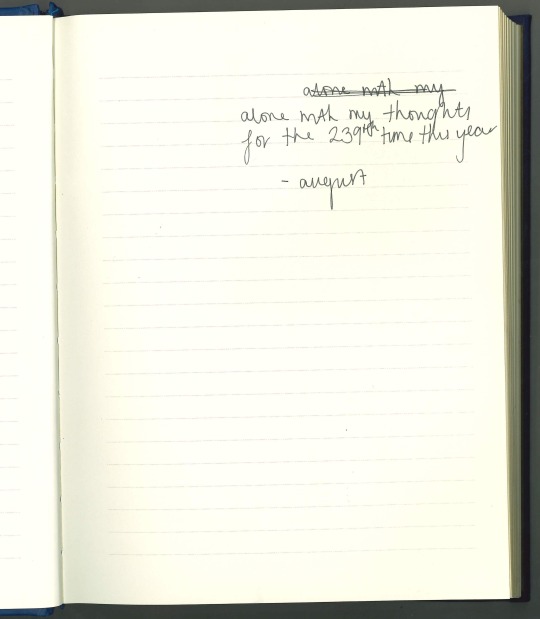
Poetry and reflective creative writing has been fundamental to my practice for this project from the very beginning. It sparked initial ideas for the work I made for my summer project and has continued to aid my ideas since. Throughout the project I have been recording my poems in journal, as well as writing them using my typewriter.
I started by simply writing up my poems and then using the most relevant ones to extract sections/lines/words in order to create a more fragmented approach. I also experimented with these extracts by repeating them as an act promoting the importance of them through the act of reiteration. Examples of the process can be seen below and in my sketchbook:
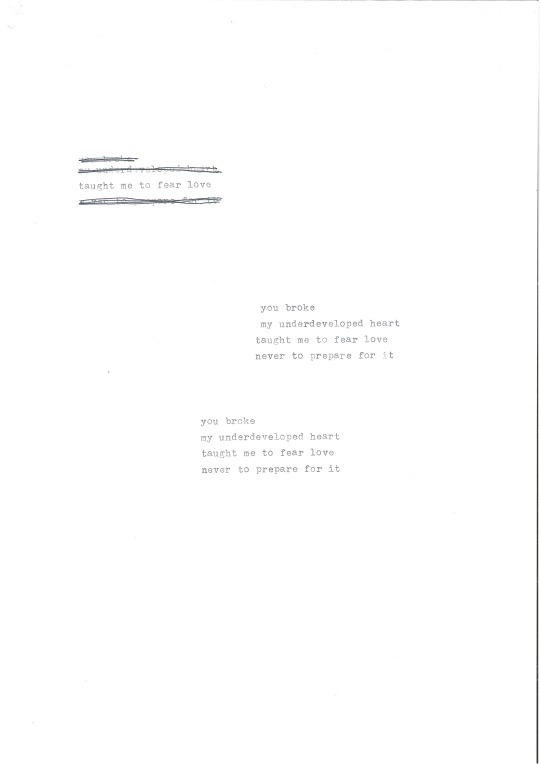

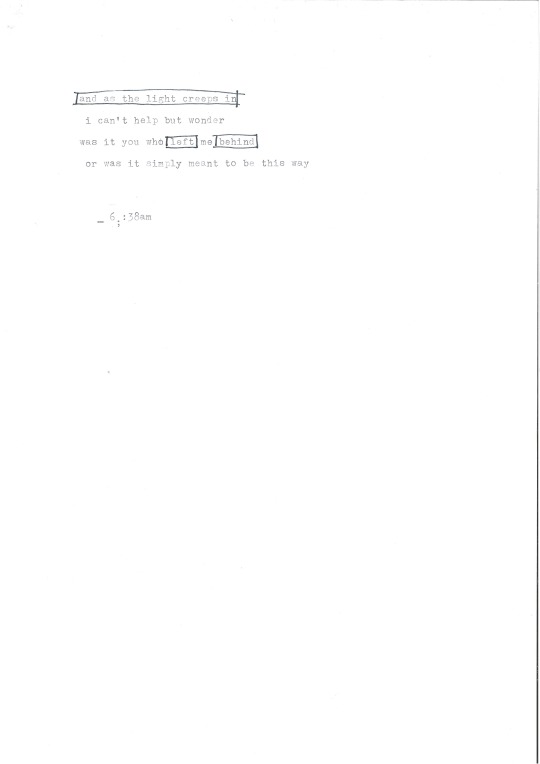
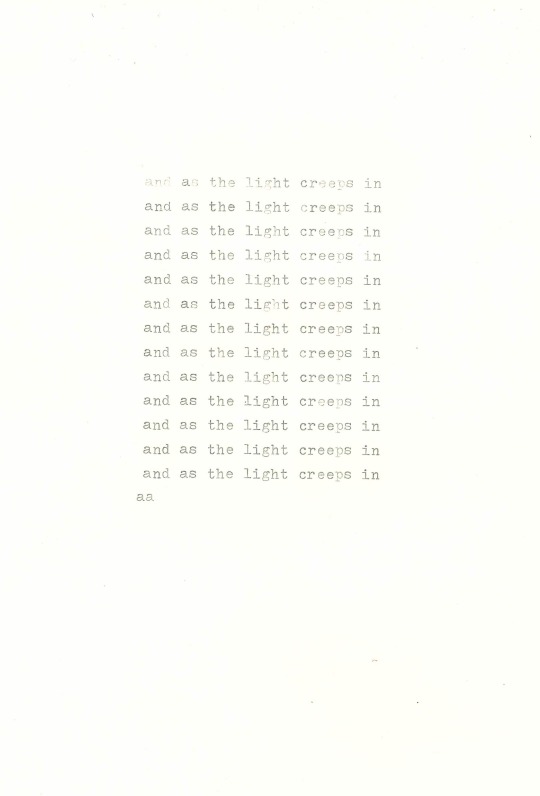
After a lot of experimentation with my poetry texts, I found that the pieces of the extracts of the poems which stated a single word or line were the most suitable for my practice because they provided just a trace of their meaning; clearly coinciding with the constant reference to trace.
During my experimentation with extracting text I also tried writing using stitch on cartridge paper (example below) (using the same process as set out above in regard to mark making). However I found this to be less successful insofar as it limiting me to only being able to write in larger font, which wasn’t fluid with the emphasis to keep my text small in the rest of my work.
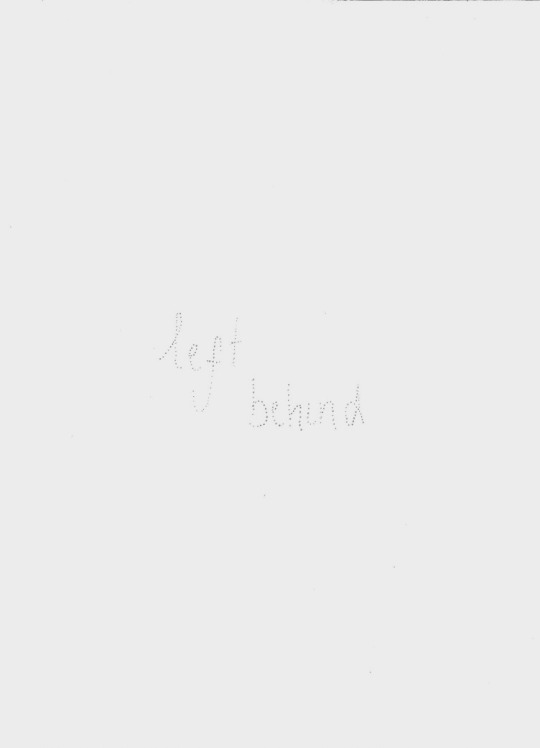
Blind drawings / drawing from memory:
A really important exploratory process during my evolving practice for this project has been the act of blind drawing and drawing from memory. A massive turning point for me has been the need to let go of perfectionism and expectations surrounding the final result of a piece, so the act of blind drawing has been so helpful in this regard. I got the idea for this process during my early contextual research when I came across Claude Heath’s blind drawings. Not only does drawing without looking force you to think more carefully about the act of drawing itself, it forces you to visualise the subject in a much clearer and detailed manner in order to transfer it to the paper. This proved very suitable when I experimented with drawing experiences and pertinent objects from memory in relation to the subject matter. For example, I used the blind drawing technique to draw items that my mum left behind when she left that are prominently fixed within my memory. I also used it as a basis for drawing certain detailed memories that I have from childhood, adding further detail to them afterwards.
This act of reflection through art practice has been so transformative for me insofar as coming to terms with certain memories and experiences through the means of using drawing to validate their realness. It is for this reason that I have chosen to include them in my final installation.
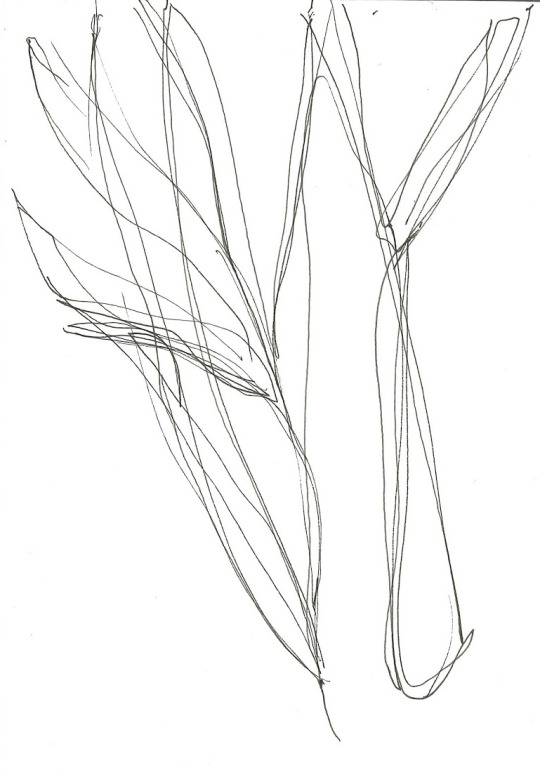

Engraving:
A further experimental medium that I have explored during this project is engraving/scratching onto coated card as a form of drawing. I started off by trying out the act of repeating the marks/forms that I have already been experimenting with. The act of repetition has been a constant experimental form throughout this project. My initial proposal discussed my intentions to explore repetition as a conceptual means of demonstrating how traumatic memories demand to be felt over and over. The process of engraving the marks, similarly to the process of engraving paper using stitch, enforces permanence; creating conceptual objects which encapsulate a snippet of memory, place and time.
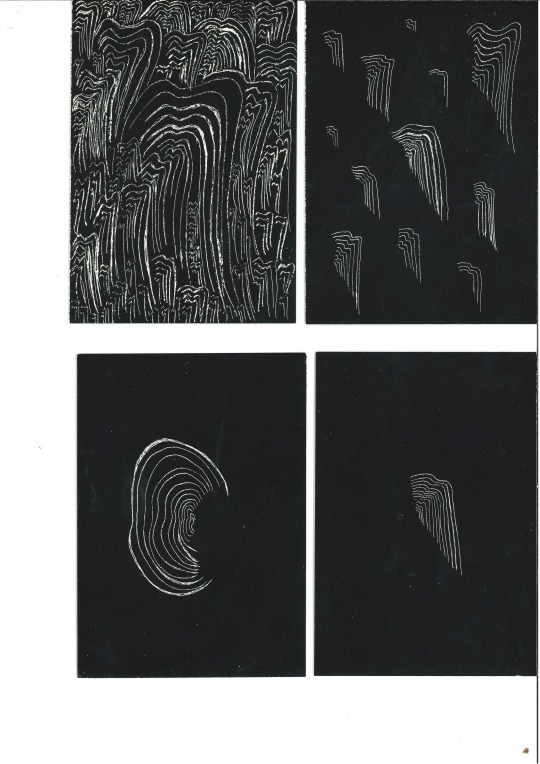
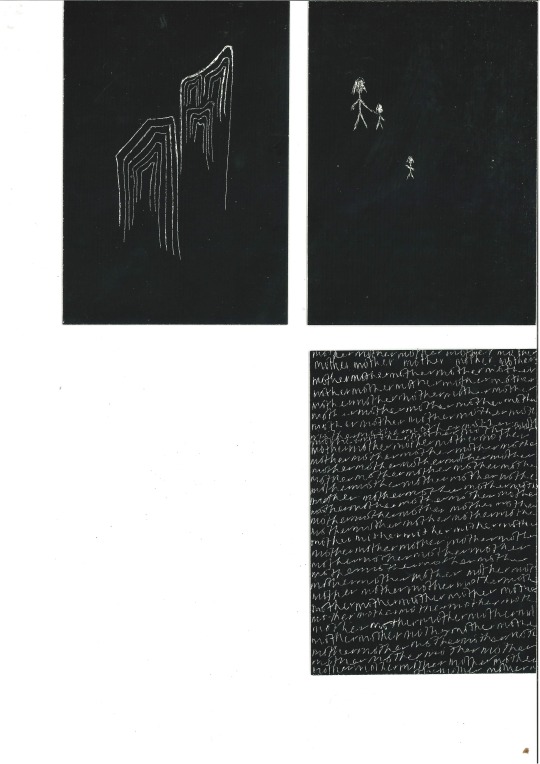
As well as mark making using this technique, I also made some drawings and text pieces; incorporating aspects from my poems and blind drawings. I am happy with how these experiments have turned out as an alternative way to draw, however I do not feel that they will be suitable for installation as they are a little more direct in their representation. My intentions for my installation is to bring together a collection of traces of memory which are not overly telling of their meaning until they are brought together.
0 notes
Text
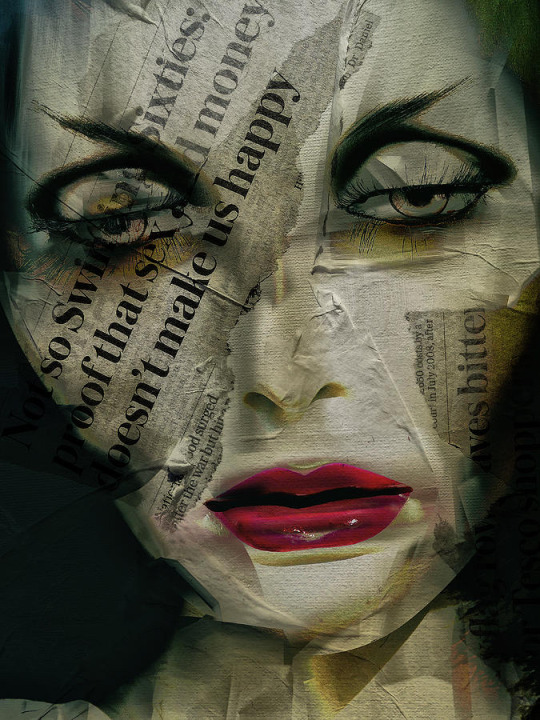
『*. Semiotic Analysis *.』
In today’s blog post we are going to be entering the world of semiotics and all that it entails. Before proceeding, with any piece of art there is meaning that can be recognized, depicted and interpreted in unique ways. These indicators of meaning can be expressed through “signs” and more likely than not, all images possess some sort of sign - no matter how obvious or obscure it may be. These “signs” enrich & deepen our understanding of the images being presented and unlock the theme/ meaning of them, to do so, the concept of semiotics is used.
Moving forward, regarding the picture that I chose, I feel that it reads more analogical. My reasoning for stating this is because I feel that the image holds a much deeper meaning than what meets the eye. With a closer observation of the image, our eyes are instantly drawn to the emotionless, uninspired woman whose face is fabricated of newspaper articles. Once reading the text displayed on the newspapers, I feel that this image is trying to convey a visual representation of how we can fall into the trap of unconsciously masking ourselves with the things that we read, in this case, the perceptions/ truths in newspapers, hence why this digital art collage is titled, ‘The Woman with The Newspaper’. Adding on to this statement, I also feel that this image is depicting a societal ideal, of obtaining/ creating the “perfect household” which doesn’t showcase the reality of an actual family but merely paints a façade of how a unit should be.
There are two primary “signs” that I hone into when viewing this image; the first being the larger, bolded text situated on the upper left-hand portion of the woman’s face and the actual face of the lady, more specifically, her eyes and the exhaustion and dullness that translate from it. Further elaborating on the first key sign of the text which reads, “Not so Swinging Sixties: proof that sex and money doesn’t make us happy”, pieced together the meaning slightly more. Upon reading that statement, I instantly associated the image to the time frame of the 60s and the way of living during that era. The ‘Swinging Sixties’, was a period where majority of families would dedicate much time to watching television and reading newspapers. There was quite a bit of external influence subconsciously and even, consciously shaping these families and reinforcing certain “norms” or “ideals” in their society/ homely environment. With regards to the meanings that I drew, families of that time absorbed these articles with a strong sense of agreement. Being that it was a vital part of where they received their information, I would expect it to, in a way, form their viewpoints on certain issues or outlooks. It’s as if their ideologies and opinions are created by what is being said in newspapers, subsiding their ability to form their own authentic perspective without the tampering of outside chit-chatter.
The secondary sign that I find significant in this image is the woman’s eyes. It’s as if her eyes are being weighed down by something, perhaps by a realized truth of reality. Nevertheless, when viewing them, you can sense the presence of fatigue and dullness. In correlation with the alternative meaning that’s grasped from this image which is of a pre-defined expectation/ illustration that’s casted of how a family unit should be, with respect to the time period, I felt that during the Sixties many families had idolized the concept of having that “quintessential” family and strived in creating that. Regardless of obtaining financial success/ stability and acquiring a love-filled partnership, there’s still a sadness... an emptiness. This may be an unfortunate awakening of how things aren’t always how the media describes/ portrays them to be or on the contrary, how by possessing all these qualities to this ideal life, that there’s still this unhappiness/ void within. Further looking into this, this can be linked with our previous meaning and that a conditioned/ pre-determined mindset of what should derive joy, ultimately limits the individual to feeling that there are only certain things created from life that can fulfill this sensation.
Utilizing Saussure’s method and returning to the first “sign” that we mentioned, the “signifier” is the bold newspaper text and its “signified” is how these articles can massively influence the family members who are reading it and are relying on external, informative outlets to define/ built their reality. The overall message is that people can fabricate their identity and have their perspectives primarily constructed based from different media sources, in this case, newspaper articles.
The objective significance that’s being represented is a statement regarding that era and how “sex” and “money” aren’t always factors in bringing joy into peoples’ lives. Another note to make of this is the large font size and boldness of the text, we can connect this to the harsh, abrupt awareness of pre-constructed expectations of life being opposed to what they originally were associated with; a fulfilling relationship + an abundance of funds = a positive life.
When viewing this image with a more subjective perspective, we can say that there’s a sadness, “let down” of this pre-conceived notion of what goes into making a happy household. When viewing the woman, like I had said earlier, it’s almost as if she’s created by newspapers, making it seem that her guiding system or source for validation comes from what she’s reading. Essentially, perceiving life with the ideals and standards of others who dictate what is massively consumed by the public - theirs’ a reliance on other people’s words rather than her own.
Delving into the secondary “sign”, which is that of the madame’s eyes, the “signifier” is her tiresome eyes and its “signified” is this mundaneness, almost spiritless approach to life where we let external media sources control our outlooks more than we realize. Adding to this, by investing time in reading these articles without questioning the validity/ accuracy of it makes us become a victim to this tailored reality/ truth.
The objective is this “unknown”, mysterious, unclear recipe of what truly is the foundation to a satisfying, fulfilling, joyful life. We can support this thought with the immense darkness that’s casted across the crease of her eyes. Objectively looking at this, we can clearly depict a more lethargic, defeated expression linked to something... an absence of some kind.
In relation to its subjective context, we can extract from this “sign”, how her eyelids are halfway shut, demonstrating that’s she’s been in this “dormant” stage where she has placed her happiness in what she has been reading and seeing with regards to exterior outlets and is now awakening to an unmatched, dishonest reality. With more of a subjective perspective, we can add, as well, that despite the droopiness/ deadness of her eyes, there is a sense of beauty found within her eyelashes. It’s as if they’re distracting this raw, authentic, and at times unattractive reality/ view of the world (her eyes) with a slightly more appealing, pleasant one (her eyelashes) which can create a false perception of reality.
To conclude, I feel that this digital art collage conveys a very powerful, important message that needs to be digested and made aware to as many as possible. Although, this image ties itself to the world of the Sixties, this still is a relevant message for our present world where we need to be mindful of the content that we’re processing and absorbing daily. We live in a society where they’re tons of truths and a plethora of information and it should be essential to be selective with what we put our time and minds into. Gratefully, we live in a world where knowledge is in the power of our fingertips and we have the capability of truly discovering what is legitimate and what ultimately, feeds our lives with authentic, true happiness. Referring to the era of the image, although the Sixties was a time where the television was making great strides in expanding and becoming an item found in many households alongside the importance of newspapers, these were two main sources to inquiring knowledge - there was a limitation with information and more of an unquestioned uniformity with how individuals/ families were supposed to live their lives. This collage can intertwine itself with the 1975 video titled, ‘The Semiotics of the Kitchen’ where Martha Rosler is making a powerful statement of how woman is confined to this pre-expected standard and role in their household and society altogether. This brilliant, simplistic video brought to light the association of the woman being linked to “a system of food production”② and that of “a system of harnessed subjectivity”②, conforming her to a limited reality and to an undeniable exposure of a definite role of her reality. It subsides the woman’s personal ambitions, dreams and goals as society is forming their reality/ expectations of them for them, they place an imaginary constraint on the woman herself as she is guided through life believing that there are only certain places where she truly belongs. Overall, I believe this image is a reminder – a reminder at how far we have come as a civilization, as a society, as humans. Although, there is still the need for improvement on aspects of our world, it does not deny the fact that there is progress that is being made and how we are living in a reality where indeed, we do consume massive amounts of information on the daily. We have awakened to the understanding of letting that knowledge affect our reality, I feel that we aren’t bound by what the world wants us to be but more so, letting our authentic selves continue to fill this world with more unapologetic, beautiful ways of life.
Works Cited
1. Hampe, Gabi. “Faces and Mixed Media.” digital art by Gabi Hampe, international copyright https://www.gabihampe.de/english-2/faces-and-mixed-media/ . (Location where image was found)
2. Iabel, Gallery. “Martha Rosler Semiotics of the Kitchen 1975.” MoMA, Gallery Iabel, 2019 The Museum of Modern Art, 15 September 2010-14 March 2011, https://www.moma.org/collection/works/88937
• Date Submitted: Sunday, October 13th, 2019 @ 12:55 AM
0 notes